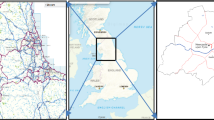Abstract
This paper is concerned with the modelling of cyclist road traffic crashes by considering the personal attributes, i.e. gender and age of the cyclists. There are 21 different types of variables considered for each crash, which broadly fall into spatial, infrastructure, and environment categories. The study area of Tyne and Wear county in the north-east of England is selected for investigation. Six deep learning-based safety models are constructed using historic crash data. The effectiveness of deep learning methodology for road safety analysis is demonstrated, and it is found that spatial, infrastructural, and environmental conditions affect the safety interactions of a particular cyclist. These variables can be used for determining/predicting safety for a rider at a location. The model can predict age and gender of the rider, which is likely to be the most unsafe based upon the specific input variables. The significant accuracy is obtained for the constructed models with an overall accuracy of 84%. It is hoped that the proposed models can help in better designing of cyclist network, design, and planning, which will contribute to a sustainable transportation system.
Access this chapter
Tax calculation will be finalised at checkout
Purchases are for personal use only
Similar content being viewed by others
References
Dolan, C.O., Stewart, K., Tricker, R., Dolan, C.O., Stewart, K.: Transport Research Institute, Edinburgh Napier University, and Reggie Tricker, Edinburgh City Council 1 (2014)
Gordon-Larsen, P., Boone-Heinonen, J.E., Sidney, S., Sternfeld, B., Jacobs Jr., D.R., Lewis, C.E.: Active and cardiovascular disease risk: the CARDIA study. Arch. Intern. Med. 169, 1216–1223 (2009). https://doi.org/10.1001/archinternmed.2009.163.Active
Bell, M.C., Galatioto, F., Fryer, C., Wang, R.: The role of cycling in delivering sustainable travel by 2050. In: 48th Universities Transport Studies Group Annual Conference, Bristol, United Kingdom (2016)
Elvik, R.: The non-linearity of risk and the promotion of environmentally sustainable transport. Accid. Anal. Prev. 41, 849–855 (2009). https://doi.org/10.1016/j.aap.2009.04.009
Transport Research Lab: Infrastructure and Cyclist Safety: Research Findings TRL Report PPR 580, Berks, UK (2011)
Bill, E., Rowe, D., Ferguson, N.: Does experience affect perceived risk of cycling hazards? In: Scottish Transport Applications Research Conference, pp. 1–19 (2015)
Beecham, R.: Exploring gendered cycling behaviours within a large, attribute-rich, transactional dataset. In: 45th Universities Transport Studies Group Annual Conference, Oxford (2013)
Bíl, M., Bílová, M., Müller, I.: Critical factors in fatal collisions of adult cyclists with automobiles. Accid. Anal. Prev. 42, 1632–1636 (2010). https://doi.org/10.1016/j.aap.2010.04.001
Rodgers, G.B.: Bicyclist deaths and fatality risk patterns. Accid. Anal. Prev. 27, 215–223 (1995). https://doi.org/10.1016/0001-4575(94)00063-R
Mindell, J.S., Leslie, D., Wardlaw, M.: Exposure-based, “like-for-like” assessment of road safety by travel mode using routine health data. PLoS ONE 7, 1–10 (2012). https://doi.org/10.1371/journal.pone.0050606
Welander, G., Ekman, R., Svanström, L., Schelp, L., Karlsson, A.: Bicycle injuries in Western Sweden: a comparison between counties. Accid. Anal. Prev. 31, 13–19 (1999). https://doi.org/10.1016/S0001-4575(98)00040-2
Aldred, R., Watson, T., Lovelace, R., Woodcock, J.: Barriers to investing in cycling: stakeholder views from England. Transp. Res. Part A Policy Pract. 128, 149–159 (2018). https://doi.org/10.1016/j.tra.2017.11.003
Gettman, D., Pu, L., Sayed, T., Shelgy, S.: Surrogate safety assessment model and validation : final report, Report No. FHWA–HRT-08-051 (2008)
IBM: IBM SPSS Neural Networks 25, New York, USA (2017)
Araujo, P., Astray, G., Ferrerio-Lage, J.A., Mejuto, J.C., Rodriguez-Suarez, J.A., Soto, B.: Multilayer perceptron neural network for flow prediction. J. Environ. Monit. 13, 35–41 (2011). https://doi.org/10.1039/b718582k
Haykin, S.: Neural Networks: A Comprehensive Foundation. Pearson Education (Singapore) Pte. Ltd (2005). https://doi.org/10.1142/s0129065794000372
Hajian-Tilaki, K.: Receiver operating characteristic (ROC) curve analysis for medical diagnostic test evaluation. Casp. J. Intern. Med. 4, 627–635 (2013)
Author information
Authors and Affiliations
Corresponding author
Editor information
Editors and Affiliations
Rights and permissions
Copyright information
© 2020 Springer Nature Switzerland AG
About this paper
Cite this paper
Malik, F.A., Dala, L., Busawon, K. (2020). Using Deep Learning to Construct a Real-Time Road Safety Model; Modelling the Personal Attributes for Cyclist. In: Analide, C., Novais, P., Camacho, D., Yin, H. (eds) Intelligent Data Engineering and Automated Learning – IDEAL 2020. IDEAL 2020. Lecture Notes in Computer Science(), vol 12490. Springer, Cham. https://doi.org/10.1007/978-3-030-62365-4_60
Download citation
DOI: https://doi.org/10.1007/978-3-030-62365-4_60
Published:
Publisher Name: Springer, Cham
Print ISBN: 978-3-030-62364-7
Online ISBN: 978-3-030-62365-4
eBook Packages: Computer ScienceComputer Science (R0)




